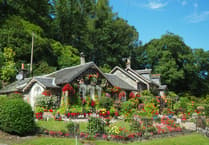Walking around the village in dismal weather, a lot of primroses on the hedges brightened up my thoughts. Some, albeit weather beaten, had three or four blooms on the plants and some with pink petals instead of the usual pale yellow/cream. They are all Primula vulgaris of course, a name that means ‘First rose’.
But the days when our hedges would be covered with primrose flowers are gone. I remember back in the forties villagers would start picking them in May and June and bunch them up, twelve blooms and three leaves and tie them with cotton or wool. Then they would be packed into a box along with bunches picked by others and sent to London by train from Saltash, where they would be sold. I’ve got to admit that I was a picker with my sisters.
However, this multiple primrose picking is not the reason that the plants are disappearing from the hedgerows. The culprit is the dreaded tractor mounted flail that cuts back the vegetation, including primrose roots, leaving it piled along the road. Back in the primrose picking days there were council workers called ‘lengths men’ who, as well as keeping all the surface water gullies clear, would trim the hedges with a pairing hook and leave it in piles beside the road. These mounds of debris would be picked up by a following lorry, making our by-roads lovely and tidy.
If I remember correctly Landrake had two lengths men, Arky Olver and Ennis Barret – there must be someone in Larrick village that remembers them! Quethiock was in the care of Tommy Snell who lived at Trehunist. Please come back! all three of you.
Hidden among some very leafy vegetation on a hedge, I spotted a really nice single red campion flower. The bloom was quite old and its deeply notched red petals were closed into thin, narrow ones but its white stamens were quite long as if waiting for a bee to pitch and pollinate it. On a clump of teasel – Dipsacus fullonum - stems and prickly seed capsules, I noticed that some of the seeds had already germinated and were showing tiny green leaves, couldn’t wait for spring I suppose.
I also came across a clump of chamomile flowers with white petals and yellow centres, that were still out in bloom despite the cold, wet and frosty weather. Known mainly as a garden flower it grows most places in the wild on grassy banks with a creeping mass of feathery, finely divided leaves. These leaves when crushed have a strong apple smell, hence their name which comes from the Greek ‘Chamaimelon’ for windfall apples.
Fungi footnote. It just shows that if you look around the countryside and keep your eyes open, you will, eventually, find something that is rare. Such was the group of Ramaria invalii fungi that I found, believe it or not, beside the road in the village. The fungi books that I have all say that this rare fungus grows on the litter beneath coniferous trees, but I found it spreading out among some leafy weeds.




